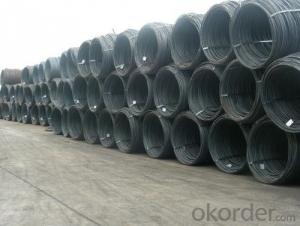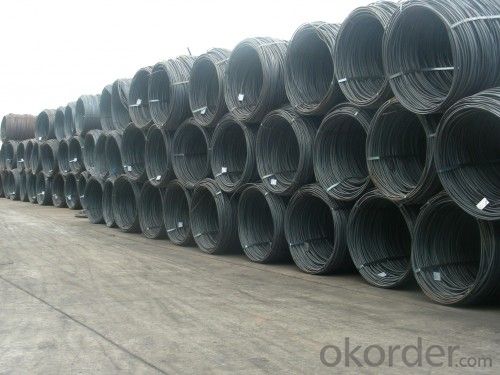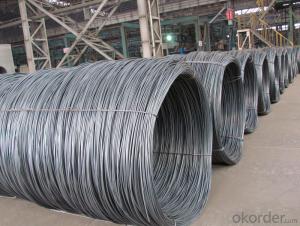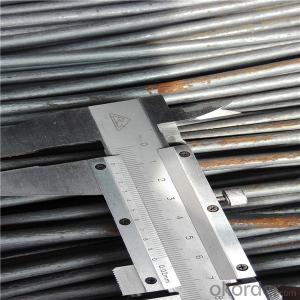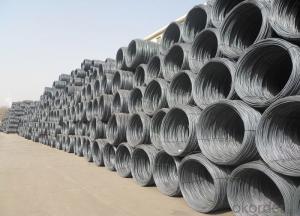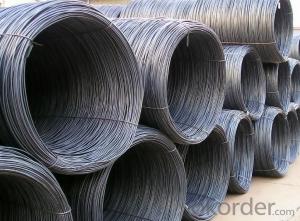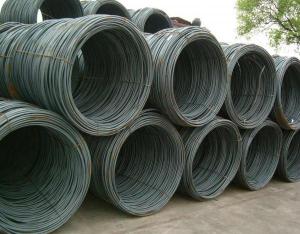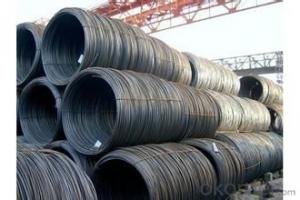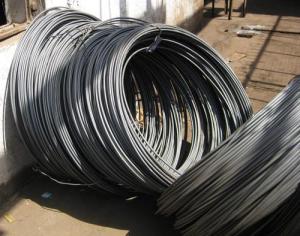Prime Hot Rolled Steel Wire Rod Low Carbon
- Loading Port:
- China main port
- Payment Terms:
- TT or LC
- Min Order Qty:
- 100 m.t.
- Supply Capability:
- 10000 m.t./month
OKorder Service Pledge
OKorder Financial Service
You Might Also Like
Specification
OKorder is offering Prime Hot Rolled Steel Wire Rod Low Carbon at great prices with worldwide shipping. Our supplier is a world-class manufacturer of steel, with our products utilized the world over. OKorder annually supplies products to African, South American and Asian markets. We provide quotations within 24 hours of receiving an inquiry and guarantee competitive prices.
Product Applications:
Prime Hot Rolled Steel Wire Rod Low Carbon are ideal for structural applications and are widely used in reinforcement of reinforced concrete and welded structure or reprocessed (roberts , nail, etc.) materials, especially used to produce wire drawing, welding electrode, nails, spring, electronic, precise machinery parts and so on.
Product Advantages:
OKorder's Prime Hot Rolled Steel Wire Rod Low Carbon are durable, strong, and wide variety of sizes.
Main Product Features:
· Premium quality
· Prompt delivery & seaworthy packing (30 days after receiving deposit)
· Can be recycled and reused
· Mill test certification
· Professional Service
· Competitive pricing
Product Specifications:
Steel Grade: Q195/235, SAE1006-1018B
Standard: ASTM, GB
Diameter: 5.5mm, 6.5mm, 7mm,8mm,9mm,10mm,12mm,14mm
Type: in coil, coil weight around 2MT
Alloy or Not: Alloy
Technique: Hot Rolled
Place of Origin: China Mainland
Surface: round, no twisted, light and smooth
Trademark | Rank | Chemical composition (quality score) % | ||||
C | Si | Mn | S | P | ||
≤ | ≤ | ≤ | ||||
Q195 | 0.06-0.12 | 0.30 | 0.25 | 0.050 | 0.045 | |
Q235 | A | 0.14-0.22 | 0.30 | 0.30-0.65 | 0.050 | 0.045 |
Q235 | B | 0.12-0.20 | 0.30 | 0.30-0.70 | 0.045 | 0.045 |
FAQ:
Q1: Why buy Materials & Equipment from OKorder.com?
A1: All products offered byOKorder.com are carefully selected from China's most reliable manufacturing enterprises. Through its ISO certifications, OKorder.com adheres to the highest standards and a commitment to supply chain safety and customer satisfaction.
Q2: How do we guarantee the quality of our products?
A2: We have established an advanced quality management system which conducts strict quality tests at every step, from raw materials to the final product. At the same time, we provide extensive follow-up service assurances as required.
Q3: How soon can we receive the product after purchase?
A3: Within three days of placing an order, we will arrange production. The normal sizes with the normal grade can be produced within one month. The specific shipping date is dependent upon international and government factors, the delivery to international main port about 45-60days.
Images:
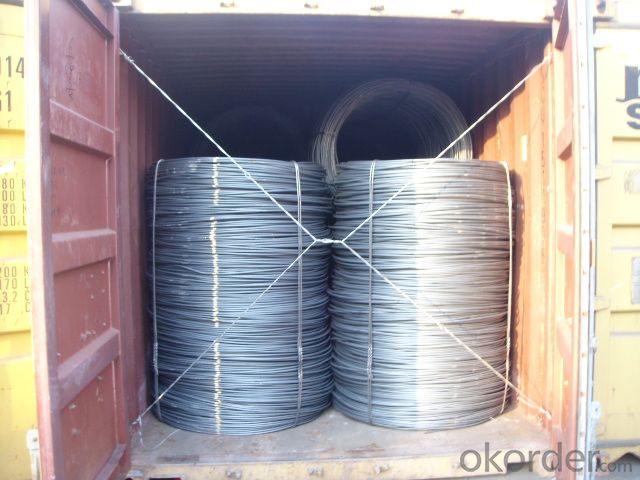
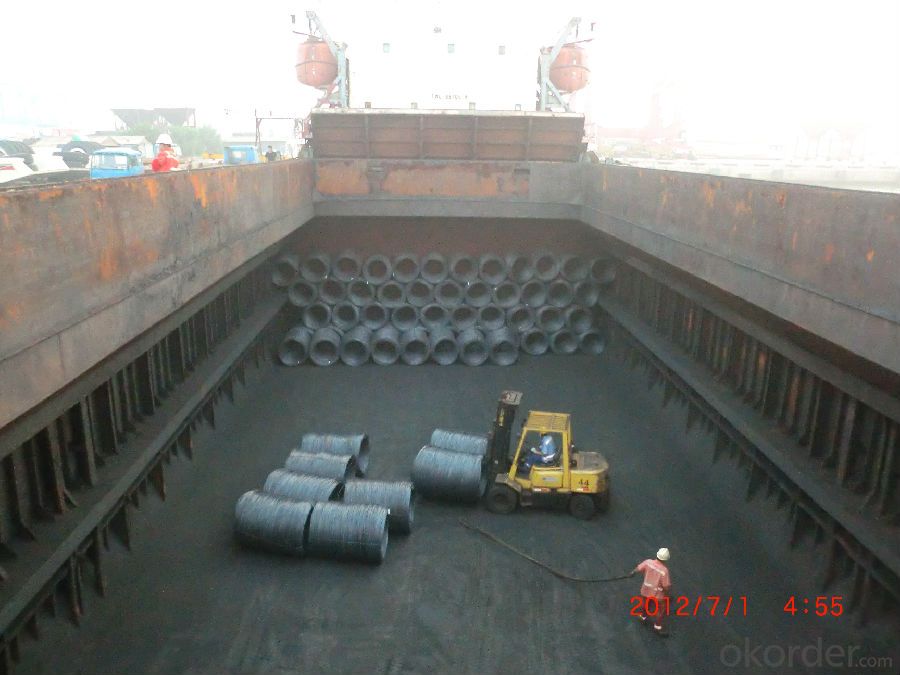
- Q: What are the different types of steel wire rod surface defect classification and grading systems?
- There are several types of steel wire rod surface defect classification and grading systems used in the industry. Some common ones include the ASTM E45 standard, which classifies defects based on their size and severity, and the ISO 4962 standard, which further categorizes defects into specific types such as cracks, scales, and pits. Additionally, some companies may have their own internal systems tailored to their specific production processes and quality requirements.
- Q: What are the different toughness testing methods for steel wire rod?
- There are several different toughness testing methods for steel wire rods. Some of the commonly used methods include Charpy impact test, notch tensile test, and fracture toughness test. These tests help assess the resistance of the steel wire rod to fractures or cracks under different conditions, ultimately determining its toughness and suitability for various applications.
- Q: How is the decarburization of steel wire rod evaluated?
- The decarburization of steel wire rod is evaluated through various methods and techniques to ensure the quality and properties of the final product. One common evaluation method is through visual inspection, where the surface of the wire rod is examined for any signs of decarburization such as discoloration or scaling. This can provide a preliminary assessment of the level of decarburization. In addition to visual inspection, chemical analysis is performed to determine the carbon content at different depths of the wire rod. This is usually done by taking samples from different sections of the wire rod and subjecting them to a carbon analysis test. The results of this analysis can reveal the extent of decarburization and help in assessing its impact on the mechanical properties of the steel wire rod. Microscopic examination is also an important evaluation technique. Metallographic analysis involves preparing thin sections of the wire rod and examining them under a microscope. This allows for a detailed examination of the microstructure and identification of any decarburized areas. The depth and severity of decarburization can be measured using specialized equipment, such as image analysis software, which helps quantify the decarburization depth. Furthermore, mechanical testing is conducted to assess the impact of decarburization on the wire rod's mechanical properties. Tensile strength, hardness, and ductility tests are commonly performed to evaluate the wire rod's overall strength and behavior under different conditions. Any significant deviation from the desired mechanical properties may indicate a higher level of decarburization. Overall, the evaluation of decarburization in steel wire rod involves a combination of visual inspection, chemical analysis, microscopic examination, and mechanical testing. These techniques provide a comprehensive understanding of the extent and impact of decarburization, ensuring that the wire rod meets the required quality standards and specifications.
- Q: What are the environmental considerations associated with steel wire rod production?
- Steel wire rod production has several environmental considerations. One of the primary concerns is the energy consumption and greenhouse gas emissions associated with the manufacturing process. Steel wire rod production requires high temperatures, which are typically achieved through the combustion of fossil fuels such as coal or natural gas. This combustion releases carbon dioxide, contributing to global climate change. Additionally, the extraction of raw materials for steel wire rod production, such as iron ore and coal, can have detrimental effects on the environment. Mining activities can lead to deforestation, habitat destruction, and soil erosion. Furthermore, the transportation of these raw materials to the production facilities can also result in additional carbon emissions. Water usage is another significant environmental consideration. Steel wire rod production requires large amounts of water for cooling purposes and the removal of impurities. This can strain local water resources, particularly in areas with limited water availability or during periods of drought. Waste management is also critical in steel wire rod production. The process generates various by-products and waste materials, including slag and dust. Proper disposal or treatment of these waste materials is essential to prevent pollution of soil, water, and air. Furthermore, steel wire rod production can have indirect environmental impacts through the use of chemicals and additives. These substances may be used for various purposes, such as corrosion prevention or enhancing the mechanical properties of the wire rod. The improper handling or disposal of these chemicals can lead to environmental contamination. To mitigate these environmental considerations, steel wire rod producers should invest in cleaner and more energy-efficient technologies, such as using renewable energy sources or implementing energy-efficient furnaces. Additionally, recycling scrap steel instead of solely relying on virgin raw materials can significantly reduce the environmental impact of steel wire rod production. Implementing water conservation measures and developing comprehensive waste management plans are also crucial to minimize the environmental footprint of this manufacturing process.
- Q: How is steel wire rod used in the manufacturing of wire for garage door springs?
- Steel wire rod is used in the manufacturing of wire for garage door springs by being heated, drawn, and coiled to form the desired wire diameter and tensile strength required for the springs.
- Q: How is steel wire rod used in the manufacturing of kitchen utensils?
- Steel wire rod is commonly used in the manufacturing of kitchen utensils due to its high strength and durability. It is often used as a raw material for shaping and forming various utensils such as whisks, spatulas, ladles, and strainers. The steel wire rod can be bent, twisted, or molded into different shapes and sizes to create the desired utensil design. Additionally, its corrosion-resistant properties make it ideal for use in kitchens where exposure to moisture and food acids is common.
- Q: What are the requirements for steel wire rod used in cable-stayed bridge wire strands?
- The requirements for steel wire rod used in cable-stayed bridge wire strands include high tensile strength, excellent fatigue resistance, and good ductility. The wire rod should have a uniform and consistent diameter, along with a smooth surface finish to ensure optimal performance and durability. Additionally, it should meet specific chemical composition and mechanical properties standards set by the relevant engineering and construction codes. Thorough testing and certification processes are also necessary to ensure the quality and reliability of the wire rod used in cable-stayed bridge wire strands.
- Q: What are the different types of steel wire rod coatings used for lubrication?
- There are several different types of steel wire rod coatings used for lubrication, each with its own unique properties and benefits. Some of the most commonly used coatings include: 1. Zinc Coating: Zinc coatings are widely used for lubrication purposes as they provide excellent corrosion resistance. The zinc coating acts as a sacrificial layer, protecting the underlying steel wire rod from rust and other forms of corrosion. Additionally, zinc coatings can also act as a lubricant, reducing friction between the wire rod and other surfaces. 2. Phosphate Coating: Phosphate coatings are often used as pre-treatments before applying other lubricant coatings. These coatings create a layer of phosphate crystals on the wire rod's surface, which enhances the adhesion of subsequent lubricant coatings. Phosphate coatings also improve the wire rod's wear resistance and provide a smooth surface for better lubrication. 3. Polymer Coating: Polymer coatings are commonly used for lubrication purposes due to their excellent friction-reducing properties. These coatings are typically made of synthetic polymers such as polytetrafluoroethylene (PTFE) or polyamide. Polymer coatings create a low-friction surface that reduces wear and tear, increases the lifespan of the wire rod, and improves its performance in various applications. 4. Wax Coating: Wax coatings are another popular choice for lubricating steel wire rods. These coatings are typically made of natural or synthetic waxes and are applied by either dipping or spraying the wire rod. Wax coatings provide a protective layer that reduces friction, prevents rust, and improves the wire rod's handling during manufacturing and processing. 5. Oil Coating: Oil coatings are commonly used for temporary lubrication of steel wire rods during storage and transportation. These coatings are typically applied as a thin layer of oil that provides immediate lubrication and corrosion protection. Oil coatings are easily applied and can be removed easily before further processing or use. It is important to note that the selection of a specific coating depends on various factors, including the desired level of lubrication, corrosion resistance, and the specific application of the wire rod. Manufacturers often consider factors such as cost, performance requirements, and environmental considerations when choosing the appropriate coating for steel wire rods.
- Q: What are the future prospects for the steel wire rod industry?
- The future prospects for the steel wire rod industry are promising, with steady growth anticipated due to increasing demand from various sectors such as construction, automotive, and manufacturing. The industry is expected to benefit from infrastructure development projects, urbanization, and the growing emphasis on renewable energy. Technological advancements and innovation in production processes will further enhance efficiency and product quality. However, challenges such as fluctuating raw material prices and competition from substitute materials need to be addressed to ensure sustained growth in the steel wire rod industry.
- Q: How is steel wire rod used in the manufacturing of piano strings?
- Steel wire rod is used in the manufacturing of piano strings as it provides the necessary strength and durability required to produce high-quality sound. The wire rod is carefully shaped and tempered to create the desired tension and elasticity, allowing the strings to vibrate and produce musical notes when struck by the piano hammer.
Send your message to us
Prime Hot Rolled Steel Wire Rod Low Carbon
- Loading Port:
- China main port
- Payment Terms:
- TT or LC
- Min Order Qty:
- 100 m.t.
- Supply Capability:
- 10000 m.t./month
OKorder Service Pledge
OKorder Financial Service
Similar products
Hot products
Hot Searches
Related keywords
